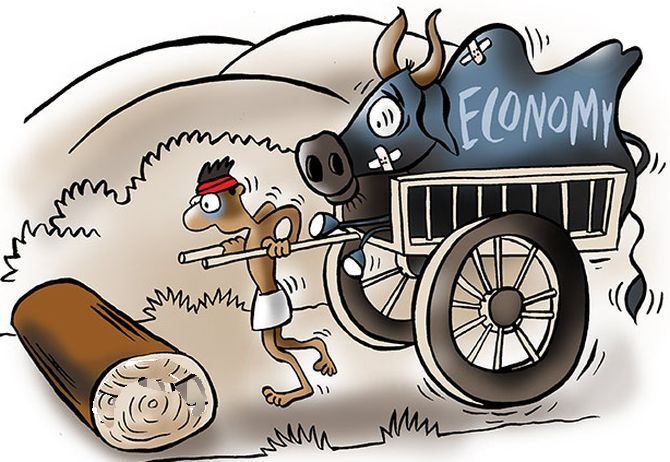From UPSC perspective, the following things are important :
Prelims level: Disguised unemployment
Mains level: India's economic stagnation, particularly in terms of industrialization and employment generation,

Central Idea:
The article explores India’s economic stagnation, particularly in terms of industrialization and employment generation, and proposes a shift towards high-skill, services-driven growth as advocated by Raghuram Rajan and Rohit Lamba in their book “Breaking the Mould: Reimagining India’s Economic Future”. It argues that traditional approaches to industrialization have not been effective in India and suggests that focusing on high-skill services, particularly in the IT sector, could stimulate manufacturing and address socio-economic inequalities.
Key Highlights:
- India’s historical struggle with industrialization despite various reform efforts.
- Proposal for a shift towards high-skill services-led growth to stimulate manufacturing.
- Critique of traditional industrial policy and its failure to address unemployment and trade deficits.
- Challenges posed by poor employment elasticity of services-led growth and inequality in the service sector.
- Impact of unequal access to education on labor market outcomes and economic disparities.
- Cultural factors contributing to India’s industrial stagnation, including undervaluing certain occupations and skills.
- Importance of mass education and collective absorptive capacity for innovation and economic development.
Key Challenges:
- Poor employment elasticity of services-led growth.
- Inequality in the service sector, particularly in terms of wages.
- Unequal access to education and skills training, exacerbating socio-economic disparities.
- Cultural attitudes towards certain occupations hindering innovation and industrial development.
- Lack of mass education and collective absorptive capacity for technological progress.
Main Terms:
- Industrialization
- Services-driven growth
- High-skill services
- Information technology (IT)
- Unemployment
- Trade deficit
- Inequality
- Mass education
- Absorptive capacity
- Technological progress
Important Phrases:
- “Premature deindustrialization”
- “Disguised unemployment”
- “Mass school education”
- “High-skill services pitch”
- “Cultural prerequisite for industrialization”
- “Useful knowledge”
- “Organic innovation in manufacturing”
- “Collective absorptive capacity”
- “Deep industrialization”
Quotes:
- “Rural entrepreneurship was able to grow out of the traditional agricultural sector on a massive scale [in China]. The rural Indian, in contrast, hampered by a poor endowment of human capital, were not able to start entrepreneurial ventures remotely on the scale of the Chinese.” – Yasheng Huang
- “India needs deep industrialization, not just the service sector, that has the power of changing the foundations of society.” – Authors (Rajan and Lamba)
Useful Statements:
- “India’s historical struggle with industrialization despite various reform efforts.”
- “Proposal for a shift towards high-skill services-led growth to stimulate manufacturing.”
- “Impact of unequal access to education on labor market outcomes and economic disparities.”
- “Importance of mass education and collective absorptive capacity for innovation and economic development.”
Examples and References:
- Periodic Labour Force Survey, 2021-22.
- Raghuram Rajan and Rohit Lamba’s book “Breaking the Mould: Reimagining India’s Economic Future”.
- Economic historian Joel Mokyr’s insights on the role of useful knowledge in economic development.
- Comparison between India and China’s approaches to rural entrepreneurship and industrialization.
Facts and Data:
- India’s manufacturing share in output and employment has been stagnant and below 20%.
- India’s trade deficit has been widening, largely driven by imported goods.
- Inequality in the service sector is higher compared to manufacturing.
- India is one of the world’s most unequal countries in terms of education.
Critical Analysis:
- The article presents a critical examination of India’s historical industrialization efforts and their limitations.
- It questions traditional approaches to industrial policy and offers a provocative alternative centered around high-skill services.
- The critique of inequality in the service sector and its implications for socio-economic disparities adds depth to the analysis.
- The cultural factors influencing India’s industrial stagnation provide valuable insights into the broader challenges faced by the country.
Way Forward:
- Emphasize the need for a comprehensive approach to economic development that addresses both industrialization and service sector growth.
- Invest in mass education and skills training to enhance collective absorptive capacity and promote innovation.
- Reevaluate cultural attitudes towards certain occupations to foster organic innovation in manufacturing.
- Ensure that economic policies prioritize reducing inequality and promoting inclusive growth.
Get an IAS/IPS ranker as your 1: 1 personal mentor for UPSC 2024

